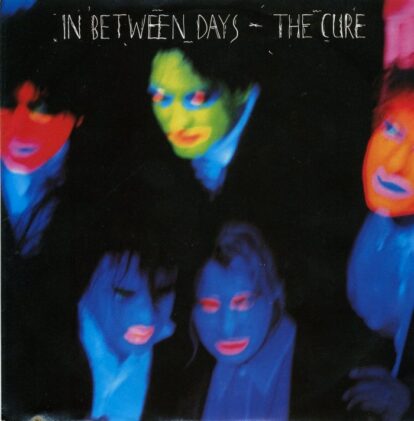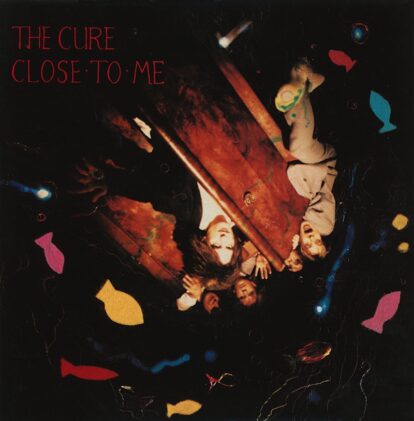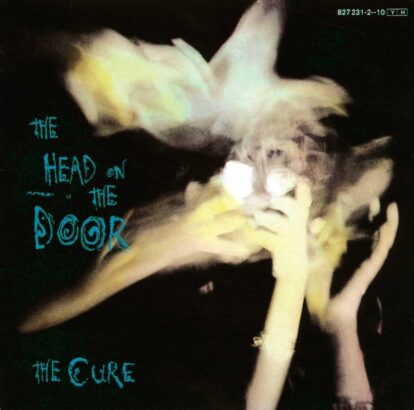The consummate Treatment album – The Head On The Door – is an eclectic brew that secured their transition from post-punk doom-mongers to bona fide pop stars and stadium fillers.
This author will always remember his treasured copy of Now That’s What I Name Music! 18 on double tape cassette, proudly attained on his sixth birthday. That small plastic case contained a humiliation of riches that, wanting again now, would underpin a lifelong obsession with searching down the right pop tune: There She Goes, It’s My Life, Suicide Blonde… However the final earworm that at all times set the cumbersome Walkman rattling to life was a observe titled Shut To Me. Nestled in between Sting and Neneh Cherry, it was a sonic bolt from the blue: a ridiculously infectious ditty, full of hooks, immediately accessible, but notably kooky and laborious to position: the naïve, throwaway nursery rhyme-like hook contrasting sharply with the eerie, strained vocals, panted in hushed whispers. It was wholly unique: cute but creepy.
Curiosity piqued, a fumble by means of the inside sleeve revealed its makers, accompanied by a thumbnail picture of a bizarre wanting man with massive hair and smudged lipstick.
It was solely a few years later that its true significance grew to become obvious. Removed from the scrumptious novelty it first appeared, it was a calling card of some of the influential bands within the historical past of widespread music. Because it occurred, the mum or dad album to which it initially belonged, 1985’s The Head On The Door, provided up much more gems. Any album that opens with the elegant In Between Days is off to a greater begin than most. Whereas that’s a troublesome act to comply with, the standard is maintained all through its 10 concise tracks, every as immediate and surprisingly alluring because the final, showcasing the numerous faces of The Treatment.
Excellent Entry Level
The Head On The Door is the right entry level into the Treatment canon, containing a little bit little bit of all their signature strikes in an simply accessible format: jangly pop (In Between Days and Push), exoticism (Kyoto Tune and The Blood), post-punk electro (Screw), straight-up pop (Shut To Me), and, after all, unbridled doom (Sinking). No matter your favorite flavour, you’ll discover it on The Head On The Door.
For his or her sixth studio album in six years, such a dive headfirst into the mainstream would have shocked many, given the trajectory The Treatment had been on just some years prior. Following their sprightly 1979 debut, they’d carved out a defiant sound, bringing fringe cult standing with their doom trilogy: Seventeen Seconds (1980), Religion (1981) and Pornography (1982) – every new launch extra uncompromising, bleak and dirge-like than the final.
In the meantime, inter-band relations grew as fractious because the music, culminating in close to implosion. Within the making certain fall out, Smith busied himself because the Banshees’ new guitarist, little question having fun with the relative anonymity of sideman. Then, seemingly out of nowhere, a reshuffled Treatment served up one thing that had been notably absent of their earlier output: whimsy. 1983 standalone single The Love Cats noticed them vamp it up with a camp, kitsch, Disney-inspired jazz pastiche. Though Smith would quickly dismiss it as “a joke”, it offered the sunshine reduction desperately wanted at that time; and it bought. 1984 single The Caterpillar adopted swimsuit.
The Head On The Door continued the pattern wholesale throughout the whole lot of an album. Smith later described this sudden swap to a poppier sound as liberating; a type of catharsis to counter the heaviness hanging over earlier data. In fact, Smith’s model of pop continues to be splendidly bizarre, idiosyncratic and unnerving.

Splendidly Bizarre
Components that one would possibly dismiss as throwaway are the snags that ensnare the listener, earlier than bludgeoning them with the lyrical assault. Smith’s lyrics are nonetheless routinely indirect, like unusual, visceral snapshots of goals or nightmares. Having taken their outdated sound so far as it may go (for now at the least), his willingness to take contemporary dangers demonstrates an growing confidence as a songwriter.
The band has at all times been a revolving door of acquainted faces, centred on the one mounted level of Robert Smith. Nonetheless, it’s not coincidental that the largely stabilised line-up he established with The Head On The Door led to their most persistently profitable run. The place earlier album, 1984’s The Prime had been virtually a solo effort, with Smith monitoring a lot of the devices himself, he had now discovered a band capable of carry his widening imaginative and prescient ahead into a brand new period.
The basic imperial part line-up was secured with returning cohorts, bass participant Simon Gallup and guitarist Porl Thompson. Porl was additionally key to the visible aesthetic, designing most of the sleeves and swirly script, together with the surreal distorted picture of his future spouse (and Robert’s youthful sister), Janet, on this album.
Crucially, it was the primary studio outing for brand spanking new drummer Boris Williams, who had joined on the earlier tour, having lately labored with the Thompson Twins. He beefed up their sound significantly with the pounding rhythms current on all their massive hits all through the late 80s and early 90s. Williams has the honour of introducing the album with that thunderous drum fill that opens out into In Between Days. All through, he produces refined shifts and prospers that add color to the beat, at all times propelling it forwards. If Smith was the artistic visionary of the songs, Williams was the driving pressure of the data.
Taught & Crisp
Whereas it’s the primary time Robert Smith is credited as the only composer, it’s very a lot a collective effort, with every of the members including tangible character to the preparations. He’s since acknowledged the importance of this band’s chops, and clearly the injection of oomph spurred him to up his personal recreation.
The opposite constant determine in The Treatment’s business transition was producer David M. Allen. A protégé of Martin Rushent, they’d labored collectively on The Human League’s Dare – a precision-tooled manufacturing triumph that fascinated Smith. Whereas the band had lengthy invested in constructing ambiance and depth on report, Allen offered the means to craft extra refined and razor-sharp preparations, usually with a definite electro twist. On this report extra so than every other, Smith mastered the artwork of utilizing the studio as an instrument, with dazzling outcomes.
Nice lengths have gone into sculpting the person parts, so that each sound uttered on that report is deliberate although delivered with a lightness of contact. A lot of The Treatment’s catalogue is characterised by ambient, washy, reverb-laden doomscapes. However, by and enormous, the manufacturing on The Head On The Door is taut and crisp, giving a way of closeness.
In stark distinction to these lengthier data, during which one observe blends into the subsequent in a single lengthy continuum, every tune is imbued with its personal signature sound. Very similar to The Creatures’ 1983 report Feast, the album takes cues from world music, flirting with unique sounds from Japan to flamenco. Whereas different makes an attempt at such eclecticism of their profession (The Prime and Wild Temper Swings) ended up sounding considerably unfocused, The Head On The Door maintains a powerful sense of cohesion. All of it meshes collectively as a physique of labor, albeit extra akin to a singles assortment.

Unmistakably The Treatment
Regardless of spawning two of the band’s largest hits, The Head On The Door is usually neglected in The Treatment’s canon, pushed apart for these massive, weighty creative statements like Disintegration, wholly worthy of the adulation heaped upon them.Whereas hardly a ‘misplaced’ report, The Head On The Door is seldom afforded the identical diploma of reverence. It’s neither epic nor singular.
However The Head On The Door is just not slowed down by such qualms. It’s contemporary and snappy. That’s exactly what makes it each immediately gratifying and enduring some 40 years later. There’s no much less integrity; the darkness is just punctured by occasional rays of dazzling, multi-spectral gentle.
In fact, to pit one model of The Treatment towards one other is to overlook the purpose. Their lasting attraction owes the whole lot to that double life, pivoting forwards and backwards between crushing doom and uplifting whimsy; counteracting an excessive amount of of 1 with a wholesome dose of the opposite.
Time has come for The Head On The Door to be celebrated because the pop masterpiece it’s. The Treatment would go on to have extra commercially profitable albums, however The Head On The Door laid the foundations to transition from cult post-punk curios to bona fide – albeit awkward – pop stars.
It’s their tackle a jukebox assortment, exhibiting them at their most creative and eclectic, whereas remaining unmistakably The Treatment. Not the “promote out” that some would possibly profess it to be. It’s merely success on their very own phrases. Solely The Treatment may get away with an album with tracks so cute and cuddly with lyrics coping with paralysis, dying and turbulent nightmares; a scrumptious mix of childlike surprise and nihilism in a single neat bundle.

The Songs
In Between Days
One in every of their most recognisable tracks, that is The Treatment at their most breezy, uplifting and life-affirming. Although lyrically, it’s laced with a way of craving and remorse of dropping a love, it carries an awesome sense of optimism, as if, nevertheless unhealthy it would really feel proper now, the whole lot goes to be simply wonderful. It’s partly this bittersweet, upbeat melancholy which has led to many New Order comparisons. It’s been lined a gazillion instances, by everybody from Kim Wilde to Korn, however none can compete with the pure majesty of the unique.
Kyoto Tune
As alluded to in its title, Kyoto Tune is a distinctly Japanese-inspired observe, taking affect from the music of Japan, with the chiming riff and crashing drums. You possibly can hear the Banshees affect, but it surely’s slower and extra brooding, skulking alongside on a Gallup bassline, whereas sustaining a really clear finger on the heartbeat. Whereas the manufacturing is slick, the lyrical imagery is harrowing: “A nightmare of you/ Of dying within the pool/ Wakes me up at 1 / 4 to 3.” That is then juxtaposed with the refrain, proclaiming that “It seems good, it tastes like nothing on earth.” It mines that basic Smith ambiguity; you’re not fairly certain of the morality of the narrator, but it surely’s thrilling nonetheless.
The Blood
The world music exoticism continues with an lively flamenco work-out, full with lightning quick, percussive, rhythmic acoustic guitars, snappy castanets, and shrill shrieks from Smith. The sounds conjure up the picture of Smith strolling down a dusty observe within the noon solar, earlier than stumbling right into a tumbledown bar, straight out of a Spaghetti Western. Lyrically, it attracts on Catholic imagery, as Smith is drawn to the iconography of the blood of Christ.
Six Completely different Methods
One in every of many showcases for The Treatment’s secret weapon and new boy, Boris Williams. A deliciously jaunty observe that journeys and stumbles over itself with bouncy piano and a squiffy, unconventional time signature on the drums. The signature piano riff was really lifted from the Banshees observe, Swimming Horses, which Smith had co-written the earlier yr. Like Shut To Me, it has a type of flute-like keyboard riffs straight out of a youngsters’s TV theme. Then in comes that basic synth string line, a attribute of The Treatment. The manufacturing is beautiful, abounding with luscious ear sweet, from the fairground piano swirls to the satisfying tom-tom fills. Once more, it’s The Treatment at their most whimsical and uplifting. An utter pleasure from begin to end.
Push
A complete change in vibe and among the finest intros in The Treatment’s canon. In anybody’s canon. Shimmering, jangly chorus-laden guitars dance up and down the fretboard, Gallup’s signature punchy bass sound pulses, then these thundering drums from Boris Williams kick in. Push is like the very best bits of In Between Days, Simply Like Heaven and Friday, I’m In Love melded collectively into an prolonged instrumental Treatment megamix. In different phrases, it’s completely ace.
It’s virtually a full two and a half minutes earlier than Robert Smith lastly shrieks “Go! Go! Go!” in sync with the instrumental hits, in exalted launch. It’s the observe with the best sense of momentum, and probably the most bombastic ‘rock’ tune on the report. It’s tempting to assume it takes a little bit inspiration from Bruce Springsteen’s widescreen guitar anthems on Born In The usA. the yr prior, although that’s maybe not a comparability Smith would instantly welcome.
The Child Screams
Opening with an electronically processed arpeggiated sound, the expectation is an proto-rave membership banger. Then it launches right into a nagging piano riff coated in delay, round a easy revolving four-chord development, pushed alongside by Gallup’s bassline and driving skittish drums. Smith wails (in the best way that solely Smith can wail) over a repetitive association. Cue extra summary allusions to goals within the lyrics, although with an ominous repeated line, commanding the listener to “strike me useless”.
Shut To Me
That infectious beat. These handclaps. That bassline, like the beginning of an outdated, long-lost Motown basic. These claustrophobic, breathy vocals, stuttered out like an unique percussion instrument. The plinky-plonky riff. The little flute riff. It’s so sparse, but appetising; so taught and exact. The one model boasts that great rasping horn part, although this isn’t current on the album model. Smith’s hushed vocalisations are pure ASMR. It’s a masterclass in minimalism and restraint.
A Evening Like This
Subsequent, a extra typical band sound; moodier, extra akin to the ambiance they’d discover additional later, on the majestic Disintegration. It has that weighty sense of foreboding and doom, however the drums preserve it pushing forwards. A screaming sax solo courtesy of Ron Howe provides one other dimension to the sound. Although it’s probably the most ‘meat and potatoes’ observe on the album, in comparison with the razor-sharp sounds elsewhere, it’s an awesome tune, and stays a dwell favorite. Its simplicity is its energy.
Screw
Once more a complete sonic shift from one tune to the subsequent. This penultimate observe is constructed round a completely stonking fuzz-bass riff from Simon Gallup. One other cracking earworm, and probably the most aggressive observe with an extreme-Nineteen Eighties city road sound. Structurally, it’s probably the most underdeveloped observe, and the shortest on the report too. All of the taut, built-up stress of the verse by no means will get the discharge into a giant poppy refrain that will push it over the sting. However that’s simply nitpicking. So far as grooves go, it’s top-notch, and certainly crying out to be sampled by Public Enemy for some hard-hitting hip-hop.
Sinking
A crashing piano sound echoes out right into a sluggish, funky groove on the drums, constructed round a skulking chorus-laden bass riff from Gallup, a spacey, reverb-y piano motif, after which the massive luscious, all-encompassing synth strings. As Smith utters the road “I’m sinking”, devoid of all hope, oodles of delay repeat the phrase round and round over itself, like a swirling whirlpool. Then as he wails “I’ll by no means really feel once more”, it reaches a nerve-tingling climax. With its lengthy, drawn-out intro, completely loaded with stress, this observe primarily units the template for Disintegration. Robert Smith clearly listened again to it and determined, “Yeah, that was nice. Let’s do a complete album of that.” 5 minutes of drawn-out doom. It’s successfully the soundtrack to the apocalypse; however in some way – it being The Treatment – these artful bastards handle to make the prospect sound so darn interesting.
For extra on The Treatment click on right here
Learn Extra: The Treatment – Want

